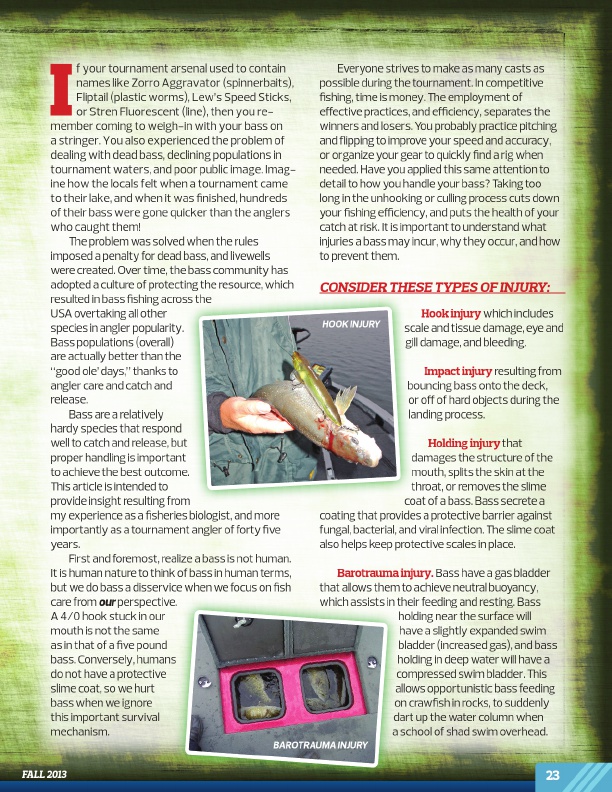
I
f your tournament arsenal used to contain names like Zorro aggravator (spinnerbaits), Fliptail (plastic worms), lew’s Speed Sticks, or Stren Fluorescent (line), then you re- member coming to weigh-in with your bass on a stringer. You also experienced the problem of dealing with dead bass, declining populations in tournament waters, and poor public image. imag- ine how the locals felt when a tournament came to their lake, and when it was finished, hundreds of their bass were gone quicker than the anglers who caught them! The problem was solved when the rules imposed a penalty for dead bass, and livewells were created. over time, the bass community has adopted a culture of protecting the resource, which resulted in bass fishing across the USa overtaking all other species in angler popularity. Bass populations (overall) are actually better than the “good ole’ days,” thanks to angler care and catch and release. Bass are a relatively hardy species that respond well to catch and release, but proper handling is important to achieve the best outcome. This article is intended to provide insight resulting from my experience as a fisheries biologist, and more importantly as a tournament angler of forty five years. First and foremost, realize a bass is not human. it is human nature to think of bass in human terms, but we do bass a disservice when we focus on fish care from our perspective. a 4/0 hook stuck in our mouth is not the same as in that of a five pound bass. Conversely, humans do not have a protective slime coat, so we hurt bass when we ignore this important survival mechanism.
everyone strives to make as many casts as possible during the tournament. in competitive fishing, time is money. The employment of effective practices, and efficiency, separates the winners and losers. You probably practice pitching and flipping to improve your speed and accuracy, or organize your gear to quickly find a rig when needed. Have you applied this same attention to detail to how you handle your bass? taking too long in the unhooking or culling process cuts down your fishing efficiency, and puts the health of your catch at risk. it is important to understand what injuries a bass may incur, why they occur, and how to prevent them.
COnsideR these types OF injURy:
hOOk inJury
Hook injury which includes scale and tissue damage, eye and gill damage, and bleeding.
Impact injury resulting from bouncing bass onto the deck, or off of hard objects during the landing process.
Holding injury that damages the structure of the mouth, splits the skin at the throat, or removes the slime coat of a bass. Bass secrete a coating that provides a protective barrier against fungal, bacterial, and viral infection. The slime coat also helps keep protective scales in place.
Barotrauma injury. Bass have a gas bladder that allows them to achieve neutral buoyancy, which assists in their feeding and resting. Bass holding near the surface will have a slightly expanded swim bladder (increased gas), and bass holding in deep water will have a compressed swim bladder. This allows opportunistic bass feeding on crawfish in rocks, to suddenly dart up the water column when a school of shad swim overhead.
BArOtrAuMA inJury
fall 2013
23